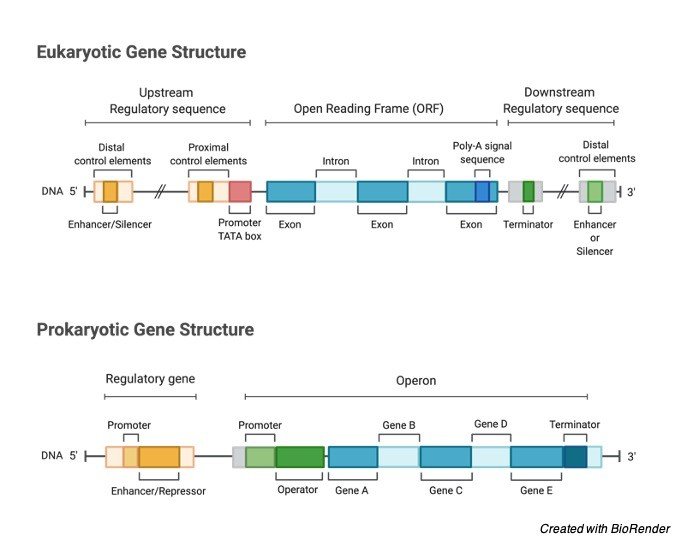What is Gene?
The term ‘gene’ was authored by Danish botanist Wilhelm Johannsen in 1909. It is the essential physical and utilitarian unit of heredity.
Heredity is the exchange of characters from guardians to their posterity that is the reason youngsters take after their folks.
An innate unit comprises of an arrangement of DNA (besides in some infections that contain RNA, all things being equal) that possesses a specific area on a chromosome and decides a specific trademark in a living being.
DNA is a tremendous substance data information base that conveys the total arrangement of directions for making every one of the proteins that a cell will at any point need.
Every gene contains a specific arrangement of instructions, normally coding for a specific protein.
Genes accomplish their belongings by coordinating protein combination. The grouping of nitrogenous bases along a strand of DNA decides the genetic code.
At the point when the result of a specific gene is required, the segment of the DNA molecule that contains that gene parts, and a corresponding strand of RNA, called courier RNA (mRNA), structures and afterward passes to ribosomes, where proteins are integrated.
A second kind of RNA, tRNA, coordinates the mRNA with explicit amino acids, which consolidate in series to shape polypeptide chains, the structure squares of proteins.
Experiments have shown that a significant number of the genes inside a cell are dormant much or even constantly, however they can be turned here and there.
There are around 30000 genes in every cell of the human body. DNA present in the gene involves just 2% of the genome.
Numerous investigations have been made on the very that discovered the area of almost 13000 genes on every one of the chromosomes.
Attributes Controlled by Genes
The human cell contains 23 sets of chromosomes. The quality is one of the attributes controlled by at least one gene. Unusual genes and genes that are shaped because of new changes additionally bring about specific characteristics.
Genes differ in size contingent upon the code or the protein they produce. All cells in the human body contain a similar DNA. The distinction between the cells happens because of the diverse sort of genes that are turned on and, in this way, produce an assortment of proteins.
Genes come two by two similarly as the chromosomes. Each parent of an individual conveys two duplicates of their genes, and each parent passes one duplicate of genes to their kid.
This is the motivation behind why the youngster has numerous qualities of both the guardians like hair tone, same eyes and so on
Elements of Genes
Genes control the elements of DNA and RNA. Proteins are the main materials in the human body which not just assistance by being the structure blocks for muscles, interfacing tissue and skin yet additionally deals with the creation of the compound.
These catalysts assume a significant part in directing different synthetic cycles and responses inside the body. Along these lines, protein union is answerable for all exercises carried on by the body and are essentially constrained by the genes.
Genes comprise of a specific arrangement of guidelines or explicit capacities.
For instance, the globin gene was told to create haemoglobin. Haemoglobin is a protein that assists with conveying oxygen in the blood.
The genetic plan contained in the nucleotide succession can decide the aggregate of a person. The inherited units, which are sent from one generation to the cutting edge are called genes.
A gene is a basic organic unit like molecule which is the key actual unit. Mendel was the primary researcher who proposed genes as particulate units and called them inherited components or variables.
In any case, the idea of gene has gone through a impressive change since Mendel’s time.
Present Day Concept of Gene
A gene can be depicted as a polynucleotide chain, which is a fragment of DNA. It is a practical unit controlling a specific attribute, for example, eye tone.
Beadle and Tatum closed by different investigations that gene is a portion of DNA that codes for one chemical.
They proposed one gene-one protein speculation. In any case, as certain genes code for proteins that are not chemicals, the meaning of gene was changed to one gene-one protein speculation.
Protein Hypothesis
The idea of gene has gone through additional progressions as the new realities became exposed. Since proteins are polypeptide chains of amino acids deciphered by mRNA, gene was characterized as one gene-one polypeptide relationship.
A few proteins have at least two various types of polypeptide chains, each with an alternate amino corrosive grouping.
They are results of various genes.
For instance, hemoglobin has two sorts of chains an andβ chains, which vary in amino corrosive arrangement what’s more, length.
They are encoded by various genes. In this manner, gene is characterized as one geneone polypeptide relationship.
Primary and Regulatory Genes
Indeed, even the one gene-one polypeptide definition isn’t finished as it does exclude gene which codes for rRNA and tRNA. Just mRNA is converted into proteins.
Thusly genes which code for polypeptides and RNAs are called underlying genes. Notwithstanding primary genes, DNA additionally contains a few successions that have just administrative capacity.
These administrative genes establish signals, which “turn on” and “turn off” the record of primary genes and perform different other administrative capacities.
In this manner the meaning of gene incorporates underlying genes just as administrative genes.
As indicated by Lodish and others, gene is characterized as the whole nucleic corrosive grouping that is vital for the combination of a practical gene item, which might be polypeptide or any sort of RNA.
Notwithstanding primary genes (coding genes) it additionally incorporates all the control arrangements and non-coding introns.
Most prokaryotic genes interpret polycistronic mRNA and generally eukaryotic genes interpret monocistronic mRNA.
Number of Genes on a Single Chromosome
Absolute number of genes on a solitary chromosome is distinctive in various living beings. Bacteriophage infection R17 comprises of just three genes, SV40 comprises of 5-10 genes.
E. coli microorganisms have in excess of 3000 genes on single 1 mm long chromosome.
Size of a Gene
In E. coli there are multiple million sets of nucleotides (4638858 base sets). It has been assessed that there are around 3000 genes in E. coli.
The base size of a gene that encodes a protein can be straightforwardly assessed. Every amino acids of a polypeptide chain is encoded by a grouping of three back to back nucleotides in a solitary strand of DNA.
Thusly by estimating the size of the polypeptide chain, the size of a gene can be straightforwardly estimated.
The normal polypeptide chain has around 450 amino acids, which are encoded by 1350 nucleotides.
Hence, in E. coli the quantity of genes will be around 3000 (4000000/1350=3000). Human genome contains around 30000 genes,
Structure of a Gene
A gene is available just in one strand of DNA, which is a twofold abandoned helix. A gene comprises of a few distinct districts.
The fundamental district is the coding arrangement which conveys data in regards to amino corrosive succession of polypeptides.

The locale on the left half of coding succession (upstream or less area) and on the right side (downstream or in addition to area) comprises of genuinely fixed administrative groupings.
Administrative arrangements comprise of advertisers which are distinctive in prokaryotes what’s more, eukaryotes.
Types of Genes
1. Straightforward Genes: Basic genes have a coding arrangement of bases in a single DNA strand. Upstream the coding area, the advertiser is available. Downstream, the end locale is available.
2. Split Genes: In the majority of eukaryotes, numerous non-coding successions are available between coding arrangements.
The coding successions of DNA of the genes are called exons. In the middle exons are available non-coding arrangements called introns.
Exons substitute with introns. Typically, introns don’t have any genetic data and are not deciphered. Such genes are called divided genes or intruded on genes.
3. Covering Genes: Most genes comprise of DNA arrangements that code for one protein. In any case, there are a few arrangements that code for more than one protein.
Fredrick Sanger found this marvel in bacteriophage φ x 174. Covering genes are normal in numerous infections.
Here the little length of viral DNA is misused for integrating unique proteins. This is accomplished in an unexpected way.
Now and again, one gene generates two proteins by having diverse beginning stages. Additionally, a similar gene generates two proteins by ending the articulation at various focuses.
In different cases, an arrangement of DNA sees no difference amongst exons and introns. This arrangement of DNA, which utilizes just exons for articulation, likewise employments bordering introns at different occasions for articulation.
The differential joining of a solitary stretch of mRNA prompts covering and, in this way, various proteins. Thusly, numerous proteins can be generated from a solitary stretch of DNA.
4. Jumping Genes or Transposons: Prior it was believed that genes are static and have clear and fixed locus. Be that as it may, as of late it has been found that sections of DNA can leap to new areas in the same or diverse chromosome.
Gene Citations
- Overlapping genes: a window on gene evolvability. BMC Genomics . 2014 Aug 27;15(1):721.
- The origin of new genes: glimpses from the young and old. Nat Rev Genet . 2003 Nov;4(11):865-75.
- Genes, genes and more genes in the human major histocompatibility complex. Bioessays . 1992 Aug;14(8):565-71.
- Origins, evolution, and phenotypic impact of new genes. Genome Res . 2010 Oct;20(10):1313-26.
Share









